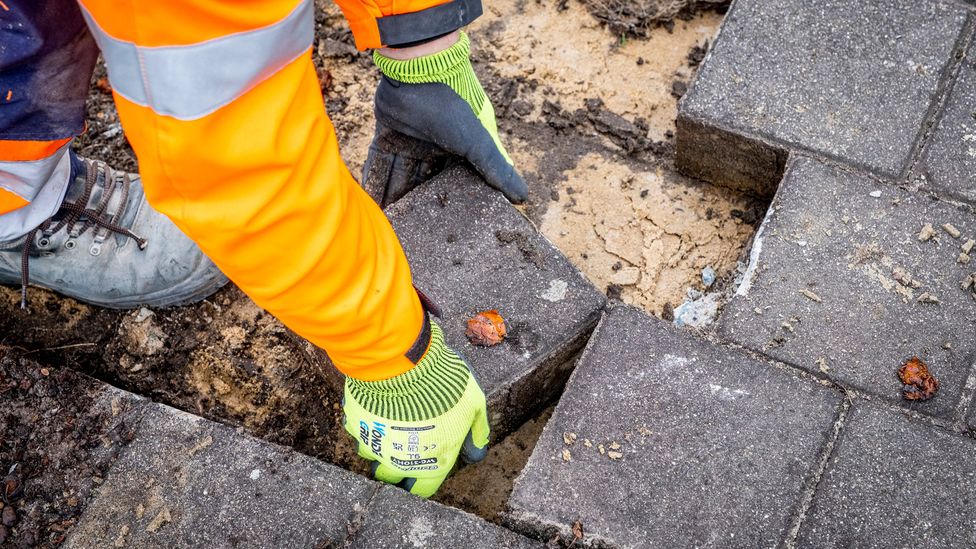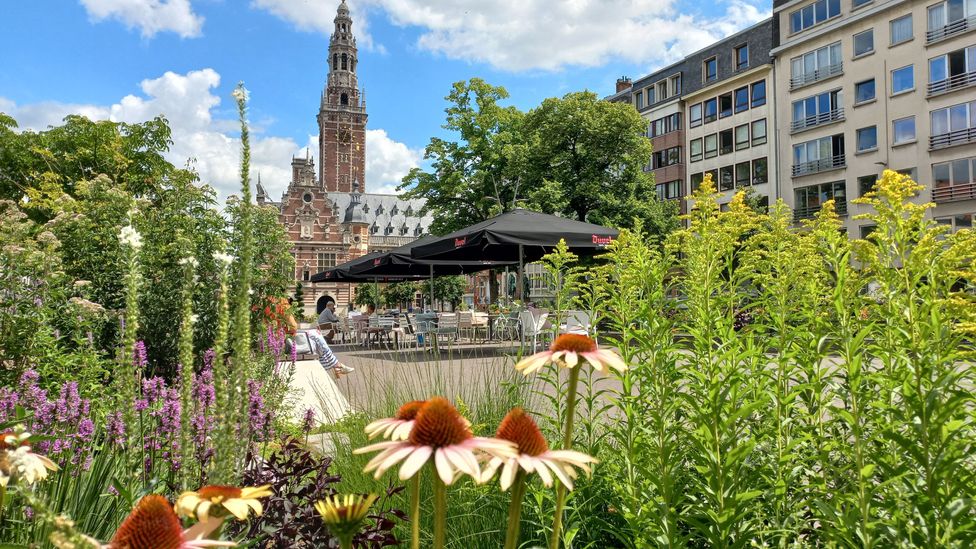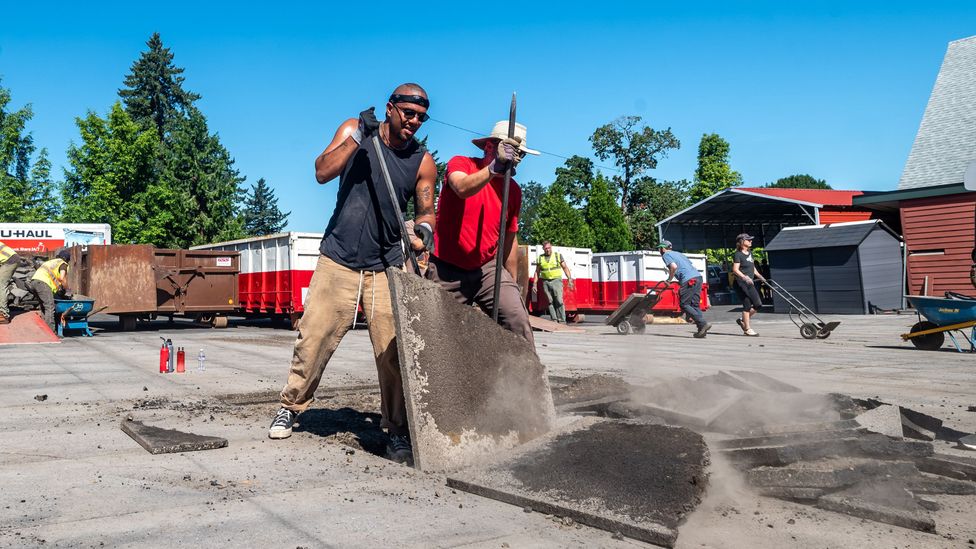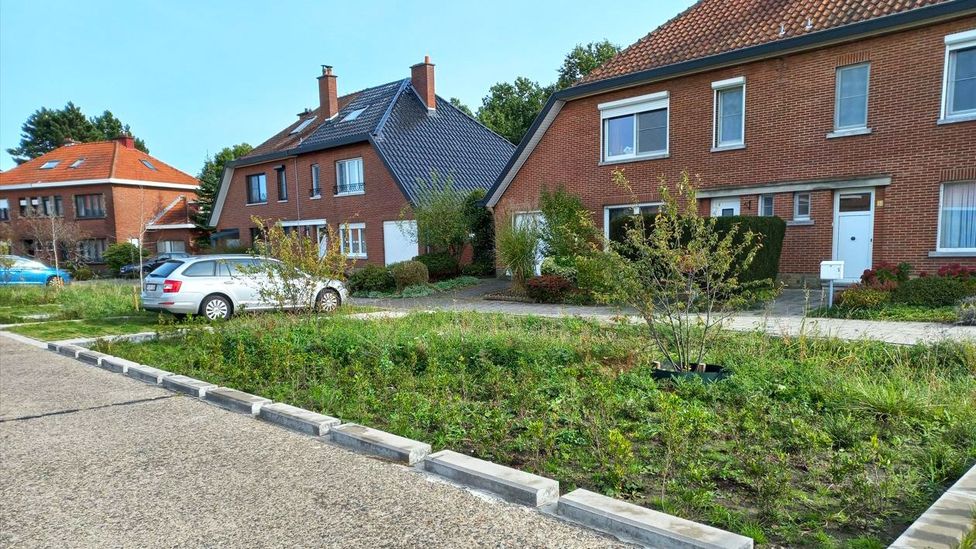The cities stripping out concrete for earth and plants
(Image credit:
City of Leuven
)

From Australia to Ontario, cities are taking up unnecessary stretches of concrete and asphalt, allowing nature to take hold in their place.
O
On a hot July day, Katherine Rose picked up a sturdy metal pole and jammed it under the tempting lip of a pre-cut concrete slab. Rose, communications and engagement director at Depave, a non-profit in Portland, Oregon, was sweating in the heat – but she was going to win this fight.
The grubby, rectangular section of urban crust in front of her was about to move. Pushing down on her metal bar, applying it like a lever, she eased the concrete covering up and away. Now sunlight could fall once again on the ground below. A mess of gravel and dirt that was, to Rose, just bursting with potential.
“It feels like you’re liberating soil,” she says, recalling the summer gathering where she and around 50 volunteers removed roughly 1,670 sq m (18,000 sq ft) of concrete from the grounds of a local church. “It’s envisioning and fully realising a dream that I think we all have,” says Rose. The dream, that is, of bringing nature back into our midst.
The idea of depaving, sometimes known as desealing, is a simple one – replace as much concrete, asphalt and other forms of hard landscaping as possible with plants and soil. It’s been around since at least 2008, when the Depave group in Portland was founded. Proponents say depaving allows water to soak into the ground, which reduces flooding in times of heavy rain – aiding the “sponginess” of cities. Native plants help wildlife cling on in urban spaces, and by planting trees you can increase shade, protecting residents from heatwaves. Injecting city streets with greenery may even improve people’s mental health, too.
But if depaving is ever going to really take off, it will have to expand beyond a handful of eager environmentalists and volunteers. With the climate crisis deepening, some cities and even entire regions are beginning to adopt depaving as part of their climate adaptation strategies. It’s time, some say, to start smashing up our concrete streets in a big way – to create spaces better for nature.

Exposing more of the ground in urban spaces can help absorb rainfall and reduce flooding, as well as boost biodiversity (Credit: City of Leuven)
Whenever Rose walks through a city these days, she can’t help but notice places where you could strike out a section of asphalt and put in some plants. “I’m constantly just wanting to do more,” she confesses. “It’s hard not to see it everywhere.”
Sign up to Future Earth
Her group says it has depaved more than 33,000 sq m (360,000 sq ft) of asphalt in Portland alone since 2008 – an area equivalent to nearly four and a half football pitches. The work is “joyous”, says Rose, because it unites enthusiastic local volunteers. They get a safety briefing and then muck in together.
Green Venture, an environmental non-profit in Ontario, Canada, has been inspired in part by the depaving projects in Portland. Giuliana Casimirri, executive director, explains how she, her colleagues, and volunteers have begun inserting miniature gardens replete with native trees in a run-down district in the city of Hamilton.
“Before, it was somewhere you would quickly try to walk through,” she says. “Now there are places you might stop or have a chat. Sit and read the paper.”
In Hamilton, flooding can cause sewage to get mixed into runoff that flows into Lake Ontario, the source of the city’s drinking water. Green Venture and other local organisations are keen to reduce the chances of that happening, says Casimirri. They view depaving as a key tactic. Certainly, studies have demonstrated that impermeable surfaces in gardens such as concrete increase flood risk in urban areas.
Rose says her group’s efforts in Portland mean that approximately 24.5 million gallons of rainwater is diverted from entering storm drains each year. In Leuven, Belgium, in 2023 alone, Baptist Vlaeminck, who leads Leuven’s Life Pact climate adaptation project, calculates that the removal of 6,800 sq metres (73,000 sq ft) of hard surfacing allowed for the infiltration of an additional 377,000 gallons (1.7 million litres) of water into the ground.
“With climate change, extreme weather rainfall events are going to increase and so [depaving is] not a nice-to-have – it’s a necessity,” Casimirri adds.
The question is whether the authorities responsible for cities, and planning, realise this. In most parts of the world, depaving can still be described as a fringe activity. “We’re going to need a scale of investment that has a lot more zeroes on it,” says Thami Croeser at RMIT University, Melbourne’s Centre for Urban Research.
Community-led and DIY efforts on driveways and on local streets with permission are fantastic, he adds, but it’s even better to think of depaving and greening as the introduction of a new kind of infrastructure in a city. It requires the same level of planning and investment as, say, a new railway.

The depave movement in Portland, Oregon has inspired a wave of cities to pull up their asphalt and concrete (Credit: Elle Hygge)
In Europe, at least, some municipalities have begun to treat depaving seriously. Residents of London in the UK are encouraged to depave their gardens, for example.
The city of Leuven in Belgium says it is embracing depaving – or “ontharden” – in a big way. The suburban district of Spaanse Kroon, home to around 550 people, is one of the latest targets of a depaving and renaturing initiative spearheaded by the city. The plans involve removing significant volumes of asphalt from the residential area and forcing cars to share the same part of the road as pedestrians and cyclists.
“We are scaling up now, we are setting up a team dedicated to depaving,” says Vlaeminck.
Such projects have to meet the needs of everyone in the city. Vlaeminck says that, to support people with impaired vision or mobility issues, unused areas of road or pavement are prioritised for depaving and sufficient space – more than a metre – is safeguarded on pavements to allow people plenty of room. Existing paving left in place is also renewed or repaired to ensure there are no bumps or unevenness. In situations where pavements are removed completely, for shared use of a roadway in low traffic neighbourhoods, Vlaeminck says depaving teams introduce measures to reduce the speed of cars.
Both Depave in Portland and Green Venture in Ontario say they work with communities to ensure accessibility requirements are met. Casimirri refers to a recent project that replaced broken, uneven concrete with shrubbery and level walkways between.
Among the initiatives instigated by Leuven is a “tile taxi” – a small truck that officials will happily send to your home so you can throw in concrete tiles or cobblestones you have removed from your garden. The material is later reused rather than thrown away, says Vlaeminck, who adds that several million euros have been set aside by Leuven to fund depaving and renaturing projects such as this.
And there’s more. Since January 2024, developers in Leuven have had to demonstrate that any rain that falls on new or significantly renovated homes can either be capture and re-used on-site or filtrate into the property’s garden rather than pool up and cause a flood. If developers can’t prove their designs are extreme rainfall-ready, they won’t be approved, says Vlaeminck.
France, too, is making depaving official, says Gwendoline Grandin, an ecologist with the Île-de-France Regional Agency for Biodiversity. Nationally, the French government has made €500m ($540m/£430m) available for urban greening – this includes depaving but also installing green walls and roofs, for example. Part of the motivation is to make towns and cities more resilient to summer heatwaves, which have badly affected parts of France in recent years.
Some of the projects now underway are significant in size, such as a former parking area near a forest in the Paris region. An area of 45,000 sq m (480,000 sq ft) has been depaved – formerly a hodgepodge of asphalt, pathways and concrete interlaced with grass. With the hard landscaping now gone, level ground is being reshaped to introduce dips and gullies that catch water, and the whole area will soon be planted over, too.

Local schemes are often backed by residents keen to see more green in their local area (Credit: City of Leuven)
In Croeser’s own city of Melbourne, he and colleagues have studied the potential space available for renaturing, if thousands of parking spaces were depaved and converted into miniature gardens. In a 2022 study, they simulated the impact based on a series of scenarios – the most ambitious of which involved removing half of the open-air parking spaces in the city, about 11,000. Croeser argues that there is sufficient off-street parking available, for example on the ground floor of buildings, in Melbourne to ensure that people wouldn’t be left without somewhere to leave their vehicle – but those interior parking spaces would need to be made publicly accessible.
Carbon Count
“The basic principle was no net loss of access to parking,” he says. “And we get 50-60 hectares [120-150 acres] of green space that keeps the city cool, prevents flooding.”
It might seem unlikely that small pockets of nature dotted here and there throughout a large city like Melbourne could benefit wildlife significantly, but Croeser says these fragments of habitat are crucial. They allow species to move around and cope in an environment that is, ultimately, very different to the one in which they evolved.
In their 2022 study on depaving in Melbourne, Croeser and his colleagues included modelling that suggested a modest increase in greenery could allow species such as the blue-banded bee to roam across a far greater area of urban habitat than before.
Rose agrees with Croeser that, for depaving to change the world, entire cities and even whole countries will have to embrace it fully. But she emphasises that, in order to reach that point, communities must express that this is something they want.
“It starts with people pushing their government and starting these conversations on a small, local level,” she says. “That’s how it takes hold.”
—
If you liked this story, sign up for The Essential List newsletter – a handpicked selection of features, videos and can’t-miss news delivered to your inbox every Friday.
Join one million Future fans by liking us on Facebook, or follow us on Twitter or Instagram.
;
.jpg)
